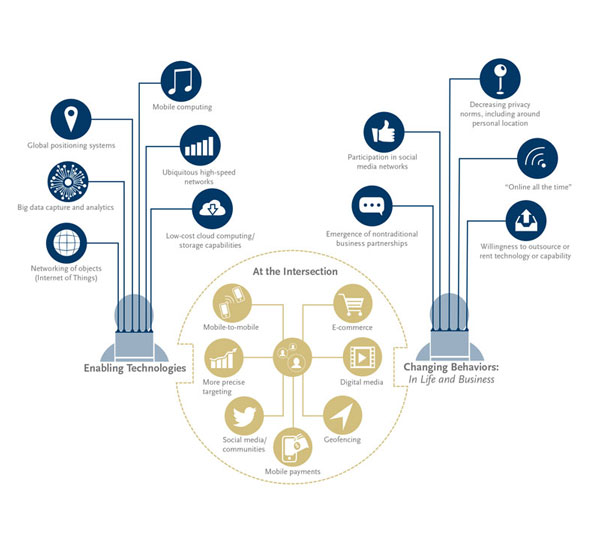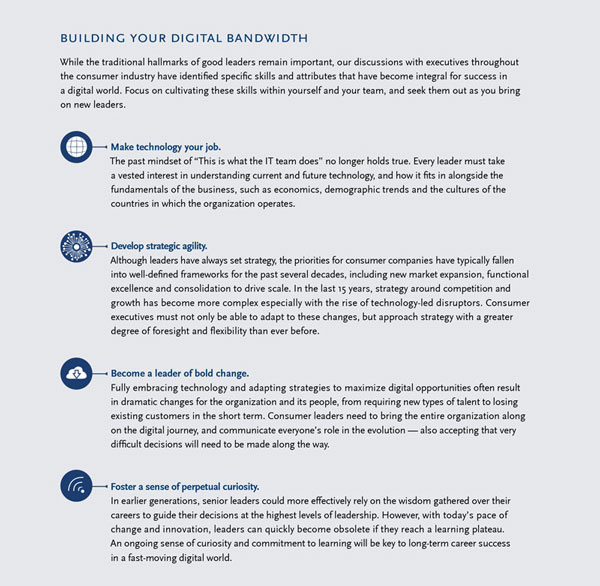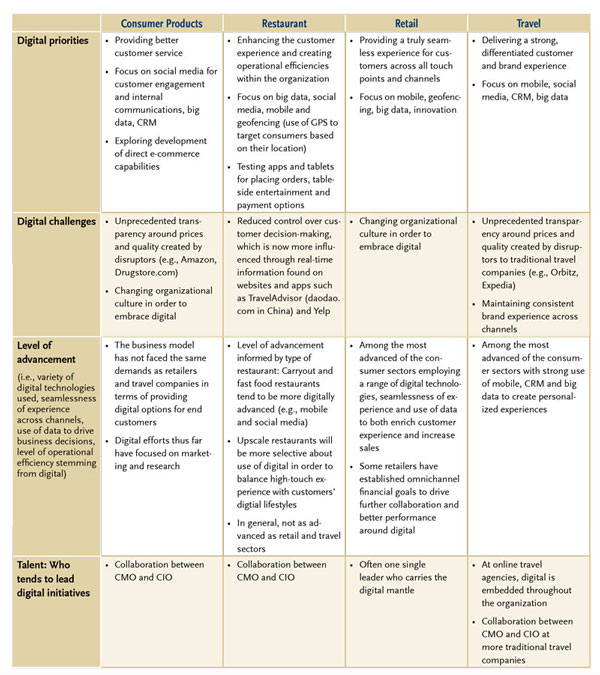“Digital” has come a long way since its origins as 1s and 0s and has quickly evolved into a strategic priority for nearly every company. As organizations wrestle with the talent and leadership implications of digital, a major obstacle to making critical decisions is often a lack of agreement about what the term even means. We classify digital as the broad range of technology-enabled advancements — including e-commerce, social media, big data and mobile computing — that are transforming how consumers live their lives and how consumer companies operate. Digital enables growing price and performance transparency, simultaneously raising customer expectations and the stakes of a competitive landscape. As channels expand and new disruptors emerge, consumer companies will need to rethink their talent strategies in a digital world where desire for seamless, personalized experiences and rich, engaging content will only continue to grow. In this series of articles, we explore how digital is impacting the consumer industry today and how companies in the consumer products, restaurant, retail and travel sectors are evolving their leadership and organizational decisions in response.
Download Now >
The Digital Journey series includes insights from executives at the following consumer companies:
| Arla Foods |
Hearsay Social |
RadioShack |
| Bloomin' Brands |
Hertz International |
Ralph Lauren |
| Brinker International |
Hudson's Bay Company |
Saks Fifth Avenue |
| Carlsberg |
Hungry Jack's |
Starbucks |
| ConAgra |
Kimberly-Clark |
Starwood Hotels & Resorts Worldwide |
| CVS Caremark Corporation |
MillerCoors |
Staples |
| CWT (Carlson Wagonlit Travel) |
Norwegian Cruise Line |
Telepizza |
| Delsey |
Orbitz Worldwide |
Travelport |
| Fossil |
Office Depot Mexico |
Vueling |
| Gropo Gigante |
PepsiCo |
Whirlpool Brasil |
| Hasbro |
Philips Brasil |
Yum! Restaurants |
Consumer companies and their leaders recognize the opportunity — and acutely feel the pressure — to reach customers through the digital technologies and communications vehicles they use the most. Yet, even as consumer companies have embraced new technology platforms and adapted to new customer expectations at a faster pace than many other industries, initial digital efforts have focused primarily on e-commerce, digital marketing tactics and more streamlined internal operations.
Many consumer companies are expanding their efforts, such as investing more heavily in data analytics and GPS-enabled technologies to provide customers with highly personalized and targeted offers based upon their previous purchases and current physical location.
We are just now entering the phase where the business landscape will change in meaningful and still somewhat unpredictable ways, and this is likely to reshape how companies think about leadership going forward. These landscape changes include:
- the rise of disruptive competitors that have built entirely different go-to-market and operating models versus traditional companies and are now achieving meaningful scale;
- evolving consumer purchase decision frameworks that are reordering the traditional marketing levers of product, brand, location, and/or perceived price advantage;
- growing product and service customization;
- new payment methods driving transaction efficiency and greater data capture; and
- more powerful loyalty programs tied to increased in data/insight.
These myriad developments of digital will continue to have significant organizational and leadership implications for each of the major consumer sectors, and each is at a different stage. We spoke with more than 35 senior executives across the consumer industry about where their companies and sectors are on their digital journey and where they hope to be in the future. Each sector has its own specific nuances, but common themes have also emerged across retail, travel, restaurant and consumer products companies. By and large, a focus on the consumer is the underpinning at nearly every company we spoke with. However, capturing the consumer’s attention (and business) is more challenging as digital disruptors in each sector have introduced previously unseen levels of transparency around pricing, features and quality. Thus, the customer experience becomes an even greater differentiator, value driver and brand asset.
Starting at the source
Before consumer leaders can identify digital priorities and the leaders they will need to help shape and execute those priorities, they must understand the two major forces driving digital: the rise of enabling technologies and changing personal behaviors. Technology enablers such as high-powered, constantly connected mobile devices are combining with changing human behaviors around the sharing of personal data and use of social media — and reshaping the consumer industry in the process.

View larger image
Consumer companies and doing digital right
The rise of digital has required that consumer companies make dramatic shifts to their leadership profiles, cultures and organizational structures to remain competitive, often in short timeframes to keep pace with rapid change. Companies in the industry have adopted some of the following practices to successfully embed digital and requisite savvy leaders into their organizations.
Building digital expertise throughout the organization, not just marketing
We have witnessed an evolution in leadership profiles as companies’ investments in digital platforms have matured and become more central to the way they do business. In the late 1990s, our searches for digital executives were conducted primarily for startups. From the early to mid 2000s, demand for heads of digital to report to the CMO came from a mix of startups and an increasing number of “traditional” companies. From 2007 to 2010, the focus shifted to finding CMOs with digital experience. Since 2010, there has been growing demand for board directors and senior functional and general management executives with digital expertise, reflecting how digital has become integral to the organization as a whole. As the technical enabler of digital, IT has advanced from being a function focused on infrastructure to one with strategic importance. Other functions will become less siloed as digital advancements continue to intertwine previously disparate groups. Functions across the organization are being required to collaborate in ways they never have before to share data, insights and expertise to fuel decision-making and execution in the name of digital.
Digital has become a strategic issue that can no longer be relegated to a single department. Thus, consumer companies today require leaders who have a strong understanding of the intersection of business and technology as well as an ability to communicate and collaborate across all functions in ways that defy traditional business frameworks. Companies need leaders throughout the organization who truly understand the customer and the various ways in which he/she is using digital technology every day.
Establishing digital as a priority from the top
Interestingly, executives from every consumer sector overwhelmingly believe that an organization’s success on the digital journey is a direct function not of its bench of tech gurus, but of the CEO. Ultimately, the CEO’s commitment to digital informs the entire organization’s priorities and actions around digital. As the CEO sets the tone from the top, there must also be digital leaders throughout the organization who can help advance the digital agenda on a daily basis.
Using culture and workspace to compete for and retain sought-after digital experts
Historically, many executives in various functions simply took it upon themselves to learn about digital — a forward-looking decision at a time when such technology was in its early stages and not as entrenched in the day-to-day operations of particular functions as it is today. But as technology becomes more advanced at a faster pace, many consumer organizations are finding that they need digital natives, and competition for talent who “grew up” in digital is fierce. Senior leaders need to understand the importance of digital and create an environment that helps attract and retain highly sought-after digital experts. Many leaders have found that their organizational culture and the style of the physical office space help attract digitally savvy candidates who typically would be drawn to the flexible, decidedly “un-corporate” environments that often characterize tech companies and startups. Seeding the organization with proven digital leaders also acts as a magnet for similar candidates and further reinforces a company’s reputation as a “best place to work” at a time when such accolades are powerful talent attractors. It is also important to note that traditional retention strategies, such as rotating talent into different roles, are not as effective because digital talent is so highly specialized. In fact, rotation can be counterproductive in certain cases,
simply serving as a springboard for talent to leave the company after acquiring additional skills.
Striking and finding the right balance of expertise
While there is not universal agreement about whether industry or digital expertise is more important, there is an emerging realization in the consumer industry that the ideal organization will require a blend of both types of talent. For example, many companies have encountered a shortage of digital and analytical candidates who are also able to manage teams. A long-tenured industry expert can provide context, content and leadership that digital natives may not have yet acquired; digital natives can bring critically important understanding of digital technologies and the wide-ranging implications for consumer behavior. As a result, companies will need to alter the expectation that a single person can carry the digital mantle and inspire and lead the rest of the organization.
Given the low supply of and high demand for the digitally savvy, companies are seeking talent from a variety of sources. Some partner with digital agencies to help fill gaps and get up to speed, and pursue digital experts from competitors, other sectors or pure-play organizations. The majority of consumer companies also realize they absolutely must invest in developing digital skills throughout the organization so that they have their own internal talent pipeline in the years to come.
Investing in your organization’s digital success
As digital technology continues to transform the consumer industry, the most significant challenge will be finding leaders who can help zero in on the best way forward for the organization. To do this, consumer companies will need to rethink their talent strategies to develop senior leaders who can meet the challenges of a digitally driven and ever-changing environment. Executives who can help their organizations succeed going forward must have a deeper understanding of technology; strategic agility to deal with a much more dynamic business environment; the bold change leadership often necessary to compete effectively; a high level of intellectual curiosity and adaptability to stay current; and a collaborative leadership style to be effective in increasingly integrated, cross-functional organizations. We hope that this exploration of the impact of digital on your sector and its implications for leadership provides insights that you can use as your organization continues on its own digital journey.

View larger image
Highlights from the Major Consumer Sectors
Digital is undoubtedly transforming the consumer industry and, while common themes have emerged across its major sectors, priorities and leadership implications can vary from one sector to the next. Following is a brief overview of how digital is affecting each of the major consumer sectors: consumer products, restaurant, retail and travel.

View larger image
For this series of articles, Spencer Stuart spoke with more than 35 senior executives to explore how companies in the consumer products, retail, restaurant and travel sectors are evolving their leadership and organizational decisions in response to digital.
Download the PDF.